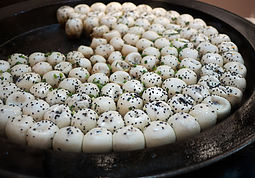
Shanghai
Living Here
Shanghai is one of the most iconic cities in world so you’ll be hard pressed to find a dull moment during your year here! You’ll find an interesting fusion of the traditional and the ultra-modern which adds to this city’s charm and excitement.

Cost of living in Shanghai
From clothes to food, buying things that are produced more locally could actually turn out to be quite a bargain. If you’re at a fabric or farmers market, it’s also common to haggle for lower prices.
If you’re used to brand-name goods however, be prepared to pay high import taxes. You may also be hard pressed to find reasonable prices when it comes to items like avocados and cherries, which seem to be rarer in China.

Accommodation Cost

The cost of living can be slightly higher in Shanghai than in other cities in China because of its huge expat population and thriving commercial sector. Buildings in Shanghai generally expand vertically rather than horizontally. However, there are a variety of housing types to choose from and you should be able to find something to your liking and to your budget.
Transportation
Being the one of the principal cities in Asia, Shanghai is one of the most easily accessible too, benefitting from reliable transport links, a huge airport and great intercity options too. This makes it a starting point for any explorer to broaden their travel opportunities during their time in Asia.

Airport
Shanghai benefits from having two international airports with over 1000 flights scheduled daily between the two of them, for domestic and international destinations, from places like Beijing and reaching as far as Paris, London, and New York City
Subway
The subway in Shanghai, like in most Chinese cities, is fast, affordable, comfortable and modern. Shanghai subway is vast and can get you nearly everywhere you desire to go, just avoid rush hour between 7:30am-9:30am and 4:30pm-6:30pm daily. Based on distance, fares can range from ¥3 to ¥11.


Train
Shanghai has three main train stations where you can take the High-Speed Railway to cities all over China, making it easy to get out of the city and explore this diverse country. Shanghai also offers ‘Holiday Trains’ which specifically take passengers to more scenic locations so you can experience a more of rural China as well.
Long-Distance Bus
Over 1,000 bus routes are available out of Shanghai over 40 different stations within the city. Expressways and highways are in abundance so you’ll not be short of routes when planning a weekend away.


Bus
Known to have one of the most substantial intercity bus routes in the world, operating around 1000 lines by numerous companies. Fares range from ¥1 to ¥2, but can sometimes be slightly more, although still considered the most cost-effective way of getting around the city.
Food
Food in Shanghai combines two different styles of cuisine: Benbang and Haipai. Benbang incorporates traditional home cooking which originated directly from Shanghai itself; it’s characterized by subtle flavors and ingredients such as fish, pork, chicken and vegetables which are often sweet and fresh. Haipai cuisine was introduced during the Qing Dynasty and takes inspiration from dishes all over China and Western food too. It includes seafood like fish, prawns and crab and has many different styles have been integrated into this type of cuisine.

Xiaolongbao
Hailing from the Jiangnan part of China, this steamed bun is particularly associated with cities which as Wuxi and, of course, Shanghai. Xiaolong (bamboo steaming baskets) are used in their preparation and they are considered a ‘soup dumpling’.

Jian Man Tou
Also a type of steamed bun but typically a traditional breakfast food. These pork-filled gelatinous dumplings are added to soup and melt into it when heated. Jian Man Tou is an established part of Shanghainese cuisine and you’ll not be short of places to scout some out for breakfast in the mornings.

Crab (da zha xie)
This crab dish is incredibly simple and delicious! The crabs are simply steamed and eaten with
Vinegar with few ingredients so the flavor of the crab really shines through. The dish is typically eaten in winter and are found in nearby rivers during this season.






